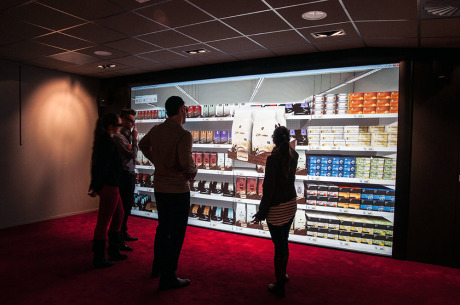Graphics and artwork are important components in the packaging mix but, as Stergios Bititsios explains, structural design must also be considered.

BRANDS and products need packaging to survive; today more than ever before.
In recent years its role has evolved from merely holding and protecting to being a platform for brand and product communications. Today, packaging goes one step further to play an integral role in enhancing the consumption experience.
So the message to manufacturers is; ignore packaging and brands and products will suffer. Packaging is the embodiment of all the functional, emotional and sensorial qualities that manufacturers try so hard to control and successfully communicate to consumers through complex brand strategies.
As such, packaging has four unique characteristics:
• It is the day to day personification of the brand: packaging is the physical manifestation of the promise that a brand is and it stands proud for that promise both at the point of sale and at the point of use.
• Its impact extends beyond the supermarket shelves: consumers’ relationship with packaging becomes more intimate and more meaningful at the point of use.
• Its impact extends beyond users themselves: when consuming a product in public all that others see is the pack and not necessarily the product.
• Its lifecycle transcends that of products: packaging the first point of contact and the last. Even after the product has been consumed the pack is still present standing for the brand
Beneath these shared qualities, packaging design fundamentally splits into two areas; structure and artwork. Both elements play a crucial role throughout the consumption cycle. However, structural design, especially in the food sector, has been somewhat overlooked. This is despite its potential to uplift a brand’s status by giving it a unique identity and uplift sales volumes through facilitating repeat purchase.
Standing out in the crowd today is a difficult task and artwork alone is not enough to tackle the problem.
Standing out in the crowd today is a difficult task and artwork alone is not enough to tackle the problem. With 40,000 goods available in the modern retail setting where consumers only spend an average of 8.5 seconds to make a purchase decision and 1/6 of a second looking at each available pack it becomes obvious that the days when artwork alone made the difference are long gone.
The three most key benefits of addressing structural design over artwork and graphics alone are perceptual superiority, increased recognition and differentiation, and longevity.
Perceptual superiority – Think about how many times you have found yourselves in a situation where you have kept pulling a door to open whilst the sign on the door was prompting you to push instead. This demonstrates how the human cognitive system has the capacity to perceive and interpret the intent of a physical three-dimensional object within a fraction of a second, whilst it takes longer to register and process text or any other two-dimensional information. Similarly, in the context of packaging, consumers’ attention and choice are stimulated mostly by the structural elements of packaging and to a lesser degree by artwork, text and on-pack communications.


Increased recognisability and differentiation – Michelangelo’s dome paintings at St Peter’s basilica are globally-recognised, iconic works of art. However, where the intricacy of the artwork is inspiring, when recalling Michelangelo’s work, many more people will remember the iconic building in the Vatican city skyline, rather than visualising the artwork itself inside the dome. The overall structure of the building has the power to create an association stronger than the intricate artwork. Evidently, structural design has a power to inspire visitors from around the globe – why not exploit its power to define the identity of packaged goods too?
Longevity – The automotive giant, BMW, has been utilising the merits of structural design to give its automobiles a unique and consistent identity for decades. No consumer needs to look at the emblem to recognise a BMW – this is instead portrayed simply in the structural design of the front grille. BMWs in the 60s and BMWs now, fifty years later, are equally and instantly recognisable. FMCG (fast-moving consumer goods) brands can achieve that too through structural packaging.
An FMCG example which adheres to all three of the criteria above is Coca-Cola. The classic contoured bottle manages to retain its iconic status and identity throughout the consumption cycle. The bottle is fully recognisable on-shelf, where packaging and product welcome together to deliver a compelling brand, yet the pack is also fully recognisable post-consumption when the bottle alone still loudly communicates the brand’s key equities. As for longevity, generations of consumers have come and gone yet this bottle is embraced and admired by everyone, and is imprinted in every consumer’s memory.
Unfortunately for the food and drink industry, Coca-Cola’s example of structural design executed well is a rarity. A walk down the cereal, bakery, or ambient food aisles finds consumers staring at a noisy collection of blocks – an undefined mass of images and colours. The sheer lack of structural definition and the busy, and easily copied, artwork make the purchase decision process a mundane and difficult task, ultimately leading to what psychologists call ‘decision paralysis’.
Once the virtues of structural packaging have been understood, how can brand owners make sure that they develop it in reality?
One might argue that producing relevant and innovative structural packaging is a complex and time consuming task and that there are far too many parameters to consider. However, the process can be simplified by having the right framework to work with and structured research approaches in place.
First, brand owners will need to embrace what we at MMR call ‘packaging architecture’. Packaging architecture is a practical model that generates actionable insights and guidelines for effective and efficient packaging development. The model is applied to the specific packaging in question and investigates:
Contextual information – Understanding of the packaging’s operational environment – in other words, where it’s used and how.
Individual needs – Appreciating consumers’ individual needs within the environment in which they’re interacting with the packaging (e.g. openability, resealability, storability, reassurance, safety, pride etc.).
Commercial and technical constraints and capabilities – This stage involves all stakeholders becoming involved to understand how a pack will work in a way which is affordable to produce and efficient to use.
In recent years, incredible structural innovations have emerged in the healthcare and personal care and laundry and home care. This innovation has so far been unmatched by the food and drink industry, demonstrating a genuine opportunity to reach out to consumers in a way which hasn’t been achieved so far through packaging design. Packaging development is a multidisciplinary and cross-functional affair, requiring a collaborative spirit and a co-creative environment.
There is no doubt that if brand owners and manufacturers encourage key stakeholders to work closely together with consumers and to pull external expertise in, they will define new frontiers and identify the rules of success for the present and for the future.











